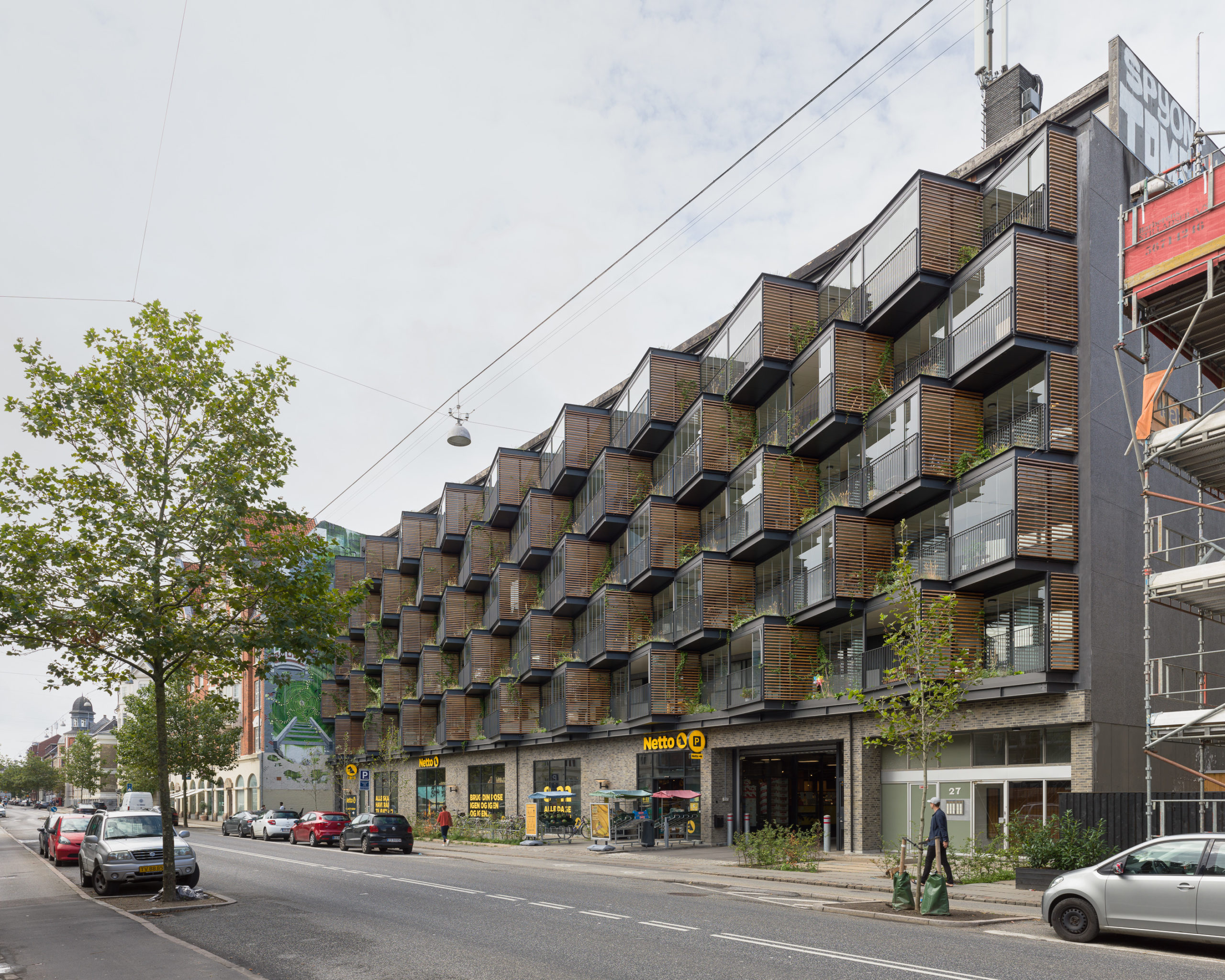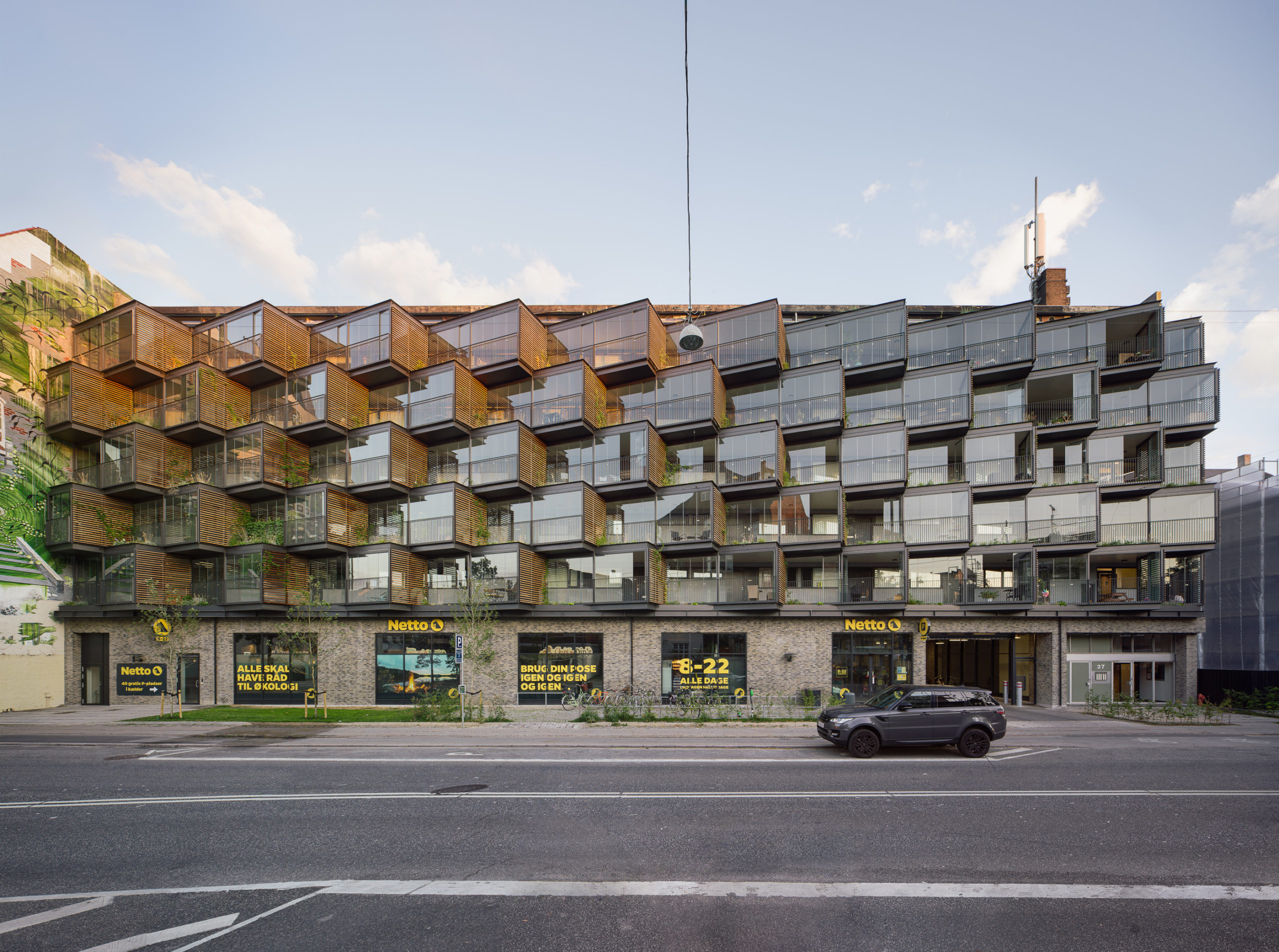The judging process for Architizer's 12th Annual A+Awards is now away. Subscribe to our Awards Newsletter to receive updates about Public Voting, and stay tuned for winners announcements later this spring.
This is the story of an apartment building in Frederiksberg, Denmark, which was often called one of the ugliest buildings in the neighborhood over the past few decades. Its continuous concrete balconies and a stark grey façade might have been associated with efficient rental architecture when it was designed by Ole Hagen Arkitekter in the 1960s, but in the 2000s, it came across as cold and isolated. Over the years, residents became plagued with rainwater-damaged walls and constant nuisance from the heavy traffic on the street beyond.
Now, the old concrete edifice has been transformed into a spectacular award-winning building that has earned praises from both the locals and the government and stands as a source of inspiration for those with new visions to transform old buildings. In an interview with Renover Denmark, residents said that they now felt proud to call this building a home. So how did this dramatic transformation come to pass?

 Instead of just addressing the water damage, Tegnestuen LOKAL came in with a vision to turn the existing façade of Ørsted Gardens into an interactive green space. “The main idea with the Ørsteds Haver project is to create a holistic environmental, social and architectural counterpoint to the pragmatic renovations that are carried out all over the country, and which often have a one-sided focus on energy,” they explain. This approach is one of the reasons that the building swept the Architecture +Renovation category in the 10th Annual A+Awards.
Instead of just addressing the water damage, Tegnestuen LOKAL came in with a vision to turn the existing façade of Ørsted Gardens into an interactive green space. “The main idea with the Ørsteds Haver project is to create a holistic environmental, social and architectural counterpoint to the pragmatic renovations that are carried out all over the country, and which often have a one-sided focus on energy,” they explain. This approach is one of the reasons that the building swept the Architecture +Renovation category in the 10th Annual A+Awards.
The idea was to create an environment that catalyzed random interactions, in turn generating new friendships between neighbors — which may sound idealistic, but has proven successful according to local residents. In addition to addressing the needs of future inhabitants, the design also takes into account the passersby and their experience of the building as they walk by it. The studio achieved this feat by creating triangular semi-private spaces to replace the older balconies. The system uses a mechanism similar to shelves where these boxes are fitted into the existing concrete structure. The bays on the bottom support the ones on the stop. Tension bands have been placed around to building to ensure that the additions don’t fall outwards.
These triangles are angled with glass on one side and a slatted screen on the other. The modules are staggered to break up a monotonous surface and also create space for planters within the gaps. Furthermore, the fifty small gardens also bleed into the interiors with small soil patches inside where residents have the option to plant their own saplings within these nooks. This helps them customize the space the way they would want it and introduces subtle differentiation between the modules. These bays also have openable glass panels to ensure that the space can be used through the different seasons. Another advantage is that this system acts as a buffer and dampens some of the noise from the busy street below.
 The small gardens set between these balconies are made of welded steel boxes that come from the manufacturer and are placed directly into these gaps. They have an automatic irrigation system as well as spouts to ensure that the excess water from the garden falls directly into the garden below, indirectly enabling them to water themselves.
The small gardens set between these balconies are made of welded steel boxes that come from the manufacturer and are placed directly into these gaps. They have an automatic irrigation system as well as spouts to ensure that the excess water from the garden falls directly into the garden below, indirectly enabling them to water themselves.
Introducing a social dimension to the building was more important to the studio than simply focusing on an energy-efficient model. “Energy renovations are effective from an economic and environmental point of view, but in their basic substance they do not take a critical view of the architecture being renovated,” they said. “Often, the architecture is simply repeated, without regard to the quality of the original project, and this unfortunately results in buildings with both poor social and environmental attributes being renovated solely with a better operating economy as the primary success criterion.”
Sustainability stands at the core of design decisions today. However, new additions might not solve the problems of current structures that consume too much power, have bad ventilation systems, don’t work with natural light and more. Additionally, the older buildings might not meet the changing needs of their residents. Think about the past two years; being locked at home during the pandemic has reminded people across the world of the importance of human contact, face-to-face conversations and the need to connect with nature for mental and physical wellbeing.
 Finding innovative ways to radically transform current buildings is something many architects will have to look into in addition to planning new net zero energy homes and offices. In instances where building-level renovations might be impossible, there are still many opportunities to retrofit water collection, solar generation, green systems or spaces that boost connectivity into the outer envelope of the building that can dramatically change how the building functions and also contribute to the wellbeing of those using it. One single project might not change the world but it sure can make a difference one community at a time.
Finding innovative ways to radically transform current buildings is something many architects will have to look into in addition to planning new net zero energy homes and offices. In instances where building-level renovations might be impossible, there are still many opportunities to retrofit water collection, solar generation, green systems or spaces that boost connectivity into the outer envelope of the building that can dramatically change how the building functions and also contribute to the wellbeing of those using it. One single project might not change the world but it sure can make a difference one community at a time.
“If we want to achieve a sustainable future, we cannot rely on only building sustainable buildings going forward. We need to have a visionary method of transforming and adapting existing buildings to meet our changing needs,” said the firm.
The judging process for Architizer's 12th Annual A+Awards is now away. Subscribe to our Awards Newsletter to receive updates about Public Voting, and stay tuned for winners announcements later this spring.









